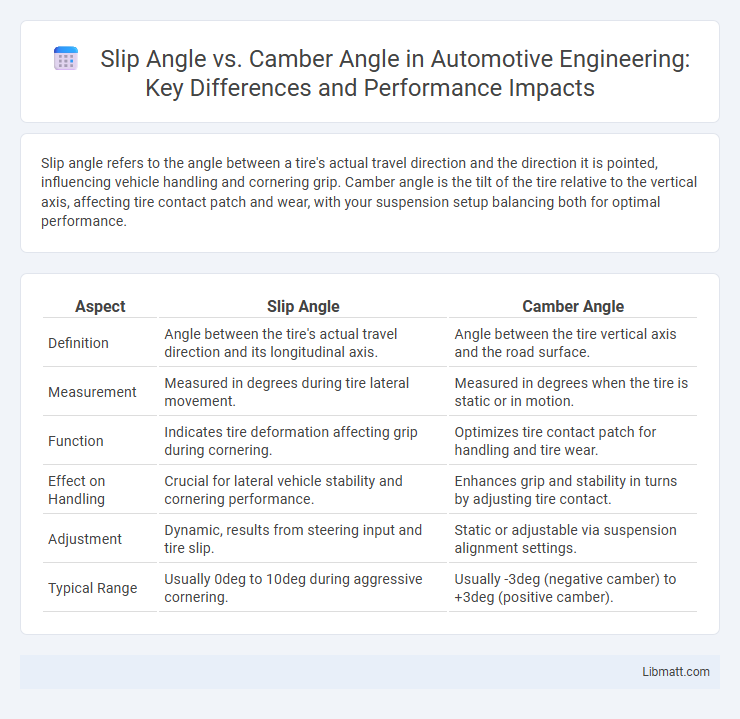Slip angle refers to the angle between a tire's actual travel direction and the direction it is pointed, influencing vehicle handling and cornering grip. Camber angle is the tilt of the tire relative to the vertical axis, affecting tire contact patch and wear, with your suspension setup balancing both for optimal performance.
Table of Comparison
| Aspect | Slip Angle | Camber Angle |
|---|---|---|
| Definition | Angle between the tire's actual travel direction and its longitudinal axis. | Angle between the tire vertical axis and the road surface. |
| Measurement | Measured in degrees during tire lateral movement. | Measured in degrees when the tire is static or in motion. |
| Function | Indicates tire deformation affecting grip during cornering. | Optimizes tire contact patch for handling and tire wear. |
| Effect on Handling | Crucial for lateral vehicle stability and cornering performance. | Enhances grip and stability in turns by adjusting tire contact. |
| Adjustment | Dynamic, results from steering input and tire slip. | Static or adjustable via suspension alignment settings. |
| Typical Range | Usually 0deg to 10deg during aggressive cornering. | Usually -3deg (negative camber) to +3deg (positive camber). |
Understanding Slip Angle: Definition and Importance
Slip angle refers to the angle between a tire's actual direction of travel and the direction it is pointed, significantly influencing vehicle handling and tire grip during cornering. Understanding slip angle is crucial for optimizing tire performance, as excessive slip angle can lead to loss of traction and reduced control. Your ability to manage slip angle enhances stability and improves overall driving dynamics, especially in high-speed or performance driving scenarios.
What is Camber Angle? Key Concepts Explained
Camber angle refers to the tilt of a vehicle's wheels relative to the vertical axis when viewed from the front or rear, affecting tire contact with the road surface. Positive camber means the top of the wheels tilt outward, improving stability, while negative camber tilts the wheels inward, enhancing cornering grip by maximizing tire contact during turns. Proper camber angle adjustment optimizes tire wear, handling performance, and overall vehicle control, especially in high-speed or racing scenarios.
How Slip Angle Influences Tire Performance
Slip angle significantly affects tire performance by determining the lateral grip during cornering, where an optimal slip angle maximizes traction and control without causing excessive tire wear. As the slip angle increases, the tire's contact patch deforms, generating side forces that improve handling but can lead to understeer or oversteer if mismanaged. Understanding your vehicle's slip angle behavior allows for precise tuning of suspension and alignment to enhance stability and responsiveness on the road.
Camber Angle’s Role in Cornering and Stability
Camber angle significantly influences cornering performance and vehicle stability by optimizing tire contact with the road during lateral maneuvers. Negative camber improves grip by increasing the tire's contact patch in corners, reducing slip angle, and enhancing traction. Your vehicle's handling responsiveness and stability are directly affected by proper camber angle settings, balancing tire wear and cornering efficiency.
Slip Angle vs Camber Angle: Core Differences
Slip angle measures the difference between a tire's actual direction and its heading during cornering, directly influencing lateral grip and vehicle handling dynamics. Camber angle refers to the tilt of the tire relative to the vertical axis, affecting tire contact patch and wear patterns. Understanding the core differences between slip angle and camber angle helps optimize your vehicle's performance by balancing grip, stability, and tire longevity.
Factors Affecting Slip Angle and Camber Angle
Slip angle and camber angle are influenced by multiple factors including tire construction, load distribution, and road surface conditions, which directly affect vehicle handling and tire performance. Tire stiffness, inflation pressure, and suspension setup also play crucial roles in determining the magnitude of both angles during cornering. Understanding these factors helps you optimize vehicle dynamics for improved traction and stability.
Impact on Vehicle Handling and Safety
Slip angle directly influences vehicle stability and cornering performance by determining the difference between the tire's actual direction and its travel path, crucial for maintaining grip during turns. Camber angle affects tire contact patch distribution, enhancing cornering ability and reducing tire wear by optimizing lateral force transfer when the vehicle leans in a turn. Proper adjustment of slip and camber angles improves handling precision, reduces understeer or oversteer tendencies, and increases overall safety by maintaining maximum tire-road friction under various driving conditions.
Optimizing Slip and Camber Angles for Best Results
Optimizing slip and camber angles is crucial for maximizing tire performance and vehicle handling. Adjusting slip angle enhances grip during cornering by balancing lateral forces, while fine-tuning camber angle improves tire contact with the road surface, reducing wear and increasing stability. Your ideal setup depends on driving conditions and vehicle dynamics, making precise calibration essential for best results.
Common Misconceptions: Slip Angle versus Camber Angle
Slip angle and camber angle are often confused, but they represent different aspects of tire dynamics; slip angle is the difference between the tire's actual direction and the direction it is pointed, affecting lateral grip during cornering, while camber angle is the tilt of the tire relative to the road surface, influencing contact patch size and tire wear. A common misconception is that slip angle is caused by camber angle, but slip angle primarily results from tire deformation under lateral forces, independent of camber settings. Understanding these distinctions helps you optimize vehicle handling and tire performance for better control and safety.
Practical Applications: Adjusting Angles for Performance
Adjusting slip angle and camber angle significantly influences vehicle handling and tire grip, critical for optimizing track performance and everyday driving stability. Increased slip angle enhances cornering by allowing tires to maintain better contact with the road during lateral forces, while precise camber angle settings improve tire wear and traction by optimizing the tire's contact patch. You can tailor these angles to your driving style and conditions, balancing agility and control for superior performance on varied surfaces.
Slip angle vs Camber angle Infographic

 libmatt.com
libmatt.com